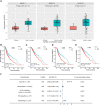ABCD3 is a prognostic biomarker for glioma and associated with immune infiltration: A study based on oncolysis of gliomas
- PMID: 35959373
- PMCID: PMC9358688
- DOI: 10.3389/fcimb.2022.956801
ABCD3 is a prognostic biomarker for glioma and associated with immune infiltration: A study based on oncolysis of gliomas
Abstract
Background: Gliomas are the most lethal primary brain tumors and are still a major therapeutic challenge. Oncolytic virus therapy is a novel and effective means for glioma. However, little is known about gene expression changes during this process and their biological functions on glioma clinical characteristics and immunity.
Methods: The RNA-seq data after oncolytic virus EV-A71 infection on glioma cells were analyzed to screen significantly downregulated genes. Once ABCD3 was selected, The Cancer Genome Atlas (TCGA), Chinese Glioma Genome Atlas (CGGA), Genotype-Tissue Expression (GTEx), Clinical Proteomic Tumor Analysis Consortium (CPTAC), and Human Protein Atlas (HPA) data were used to analyze the relationship between ABCD3 expression and clinical characteristics in glioma. We also evaluated the influence of ABCD3 on the survival of glioma patients. CIBERSORT and Tumor Immune Estimation Resource (TIMER) were also used to investigate the correlation between ABCD3 and cancer immune infiltrates. Gene set enrichment analysis (GSEA) was performed to functionally annotate the potential functions or signaling pathways related to ABCD3 expression.
Results: ABCD3 was among the top 5 downregulated genes in glioma cells after oncolytic virus EV-A71 infection and was significantly enriched in several GO categories. Both the mRNA and protein expression levels of ABCD3 were upregulated in glioma samples and associated with the prognosis and grades of glioma patients. The Kaplan-Meier (K-M) curve analysis revealed that patients with high ABCD3 expression had shorter disease-specific survival (DSS) and overall survival (OS) than those with low ABCD3 expression. Moreover, ABCD3 expression could affect the immune infiltration levels and diverse immune marker sets in glioma. A positive correlation was found between ABCD3 and macrophages and active dendritic cells in the microenvironment of both the GBM and LGG. Gene sets including the plk1 pathway, tyrobp causal network, ir-damage and cellular response, and interleukin-10 signaling showed significant differential enrichment in the high ABCD3 expression phenotype.
Conclusion: Our results suggested that ABCD3 could be a potential biomarker for glioma prognosis and immunotherapy response and also further enriched the theoretical and molecular mechanisms of oncolytic virus treatment for malignant gliomas.
Keywords: ABCD3; biomarker; glioma; immune infiltrates; oncolytic virus.
Copyright © 2022 Li, Zhang, Qu, Ding and Yin.
Conflict of interest statement
The authors declare that the research was conducted in the absence of any commercial or financial relationships that could be construed as a potential conflict of interest.
Figures






Similar articles
-
Deciphering the role of QPCTL in glioma progression and cancer immunotherapy.Front Immunol. 2023 Mar 29;14:1166377. doi: 10.3389/fimmu.2023.1166377. eCollection 2023. Front Immunol. 2023. PMID: 37063864 Free PMC article.
-
MCM10 as a novel prognostic biomarker and its relevance to immune infiltration in gliomas.Technol Health Care. 2023;31(4):1301-1317. doi: 10.3233/THC-220576. Technol Health Care. 2023. PMID: 36872806
-
SYT16 is a prognostic biomarker and correlated with immune infiltrates in glioma: A study based on TCGA data.Int Immunopharmacol. 2020 Jul;84:106490. doi: 10.1016/j.intimp.2020.106490. Epub 2020 Apr 11. Int Immunopharmacol. 2020. PMID: 32289666
-
Ferroptosis-related NFE2L2 and NOX4 Genes are Potential Risk Prognostic Biomarkers and Correlated with Immunogenic Features in Glioma.Cell Biochem Biophys. 2023 Mar;81(1):7-17. doi: 10.1007/s12013-022-01124-x. Epub 2023 Jan 11. Cell Biochem Biophys. 2023. PMID: 36627482 Free PMC article. Review.
-
Emerging immune-based technologies for high-grade gliomas.Expert Rev Anticancer Ther. 2022 Sep;22(9):957-980. doi: 10.1080/14737140.2022.2110072. Epub 2022 Aug 12. Expert Rev Anticancer Ther. 2022. PMID: 35924820 Review.
Cited by
-
Mechanism of ABCD3 inhibiting colorectal cancer progression by regulating Wnt/β-catenin.Mol Biol Rep. 2025 Jul 16;52(1):727. doi: 10.1007/s11033-025-10825-4. Mol Biol Rep. 2025. PMID: 40668324
-
Quantitative Proteomics Reveal the Role of Matrine in Regulating Lipid Metabolism.ACS Omega. 2024 May 29;9(23):24308-24320. doi: 10.1021/acsomega.3c09983. eCollection 2024 Jun 11. ACS Omega. 2024. PMID: 38882153 Free PMC article.
-
Tutorial: design, production and testing of oncolytic viruses for cancer immunotherapy.Nat Protoc. 2024 Sep;19(9):2540-2570. doi: 10.1038/s41596-024-00985-1. Epub 2024 May 20. Nat Protoc. 2024. PMID: 38769145 Review.
-
Oncolytic Virus Infection Modulates Lysine Acetyltransferase in Gliomas: Comprehensive Analysis and Experimental Validation of KAT8 in Glioma.J Cell Mol Med. 2025 Apr;29(8):e70558. doi: 10.1111/jcmm.70558. J Cell Mol Med. 2025. PMID: 40259204 Free PMC article.
-
Mendelian Randomization Analysis of Mitochondria-Related Genes and Screening of Prognostic Genes in Colorectal Cancer.Cancer Med. 2025 Jul;14(13):e71012. doi: 10.1002/cam4.71012. Cancer Med. 2025. PMID: 40620061 Free PMC article.
References
Publication types
MeSH terms
Substances
LinkOut - more resources
Full Text Sources
Medical
Miscellaneous

